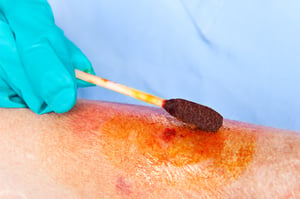 Having undergone radiation therapy as part of cancer treatment is difficult enough. Patients have been dealing with a cancer diagnosis, the difficult treatment process, and all that comes along with it. Something else to worry about is the very last thing a patient needs, but when radiation therapy produces non-healing wounds or ulcers, this is precisely what happens.
Having undergone radiation therapy as part of cancer treatment is difficult enough. Patients have been dealing with a cancer diagnosis, the difficult treatment process, and all that comes along with it. Something else to worry about is the very last thing a patient needs, but when radiation therapy produces non-healing wounds or ulcers, this is precisely what happens.
How do Wounds Occur from Radiation?
About half of all patients diagnosed with cancer will have radiation therapy included in their course of treatment. However, while radiation is used in an attempt to shrink or eradicate cancerous cells, the surrounding skin and tissue can be damaged. In fact, up to 95 percent of all radiation therapy recipients will develop a skin reaction, known as radiation dermatitis, to some degree. Based on the dose of radiation, beam used, and amount of time the skin is exposed, these injuries can involve the skin, underlying tissues, and even structures as deep as bone.
Symptoms and Risk Factors of Radiation Dermatitis
Wounds from radiation can present a unique challenge, particularly in those who are already immunosuppressed. Understanding the risk factors and early signs of radiation dermatitis are a vital part of minimizing damage to the skin and maintaining both patient health and comfort.
While the likelihood of experiencing a skin reaction from radiation is high for everyone, there are other factors which can increase this risk and contribute to more severe reactions. Patients who are obese, have an existing skin condition, or have been diagnosed with certain diseases such as HIV or diabetes are especially susceptible. These patients and others must be mindful of the signs of radiation dermatitis and address them as soon as they appear. These can include:
- Redness
- Itching
- Peeling or flaking
- Soreness or tenderness
- Blistering
- Changes in skin pigmentation
Treating Radiation Wounds
Treatment protocol for wounds resulting from radiation is based on a multitude of factors regarding the patient, their health, and the severity of the wound. In some cases, prescription ointments or special wound dressings may be enough to allow the skin to fully recover. However, in the case of more severe or non-healing wounds, hyperbaric oxygen therapy may be needed. During this therapy, the patient will spend time in a pressurized chamber, where 100 percent pure oxygen is used to supercharge the wound healing process and protect against infection.
To learn more about wound treatment after radiation and hyperbaric oxygen therapy in the Baton Rouge area, contact Lane Wound Care & Hyperbaric Oxygen Therapy Center. Our team of experts can help assess the state of the wound and provide the most efficient treatment methods possible to heal and protect the skin.



.png?width=110&height=110&name=lane%20badge%20(1).png)
